It’s a common figure of speech to say that x is worth its weight in y, where y is usually (but not always) gold. But most of us don’t buy and weigh gold very often, so how do you connect that to real life? Does “worth its weight” in pennies or $100 bills make any more sense?
We have collected here a bunch of examples for different things that represent a wide range of monetary value per unit weight, in what might make a useful
calibration chart for your future idiomatic usage.
Let’s start this off with a down-to-earth question. Which has a higher monetary density: dimes or quarters? In other words, if you had to carry around $1000 worth of either dimes or quarters, which should you ask for?
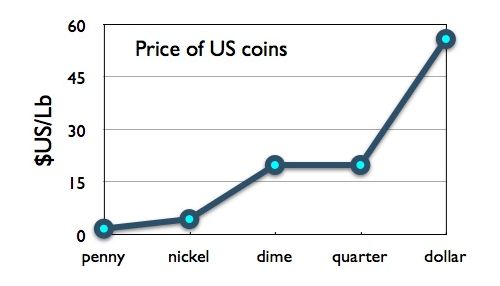
And… surprisingly enough, dimes and quarters have the same density, about $4.50 $20 per pound, so you can pick either. (But as you can see, nickels are mighty inefficient. Avoid carrying them in your pockets whenever possible. )
On a related topic, paper bills weigh about 1 gram each. The monetary density of paper currency makes much more sense– just look at that beautiful curve. Clearly, bigger bills are better.
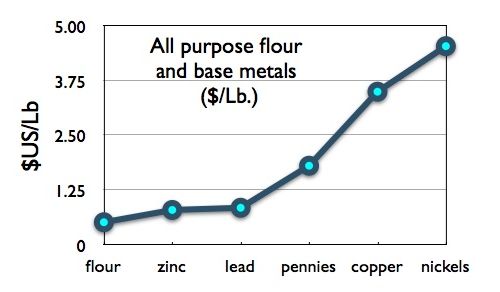
Alongside US coins we have such staples as all-purpose flour and base metals. Interesting that copper is worth so much more than pennies are– but pennies these days are only 2.5% copper, the rest is cheap zinc. (In fact, pennies haven’t been
made of plain copper since 1837.)
[Aside: The commodity prices that we cite here are all rough estimates, believed to be more-or-less correct as of August 2008. See the table at the end for references.]
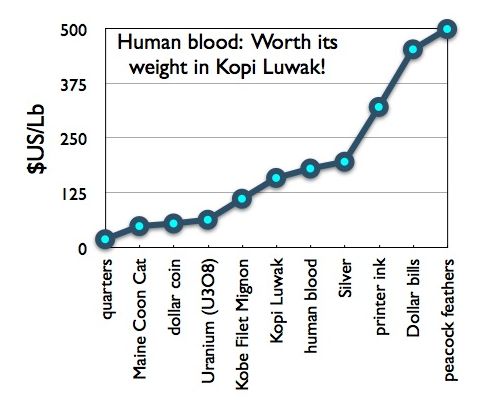
Kopi Luwak coffee costs approximately the same amount per pound as human blood. (Knowing where it comes from, I think I’d rather drink the blood. It’s been pointed out before that printer ink is also up there, but I’d rather not drink that either.)
Would you have guessed that peacock feathers can be worth more than their weight in dollar bills? Or that a fancy steak costs twice as much as its weight in dollar coins?
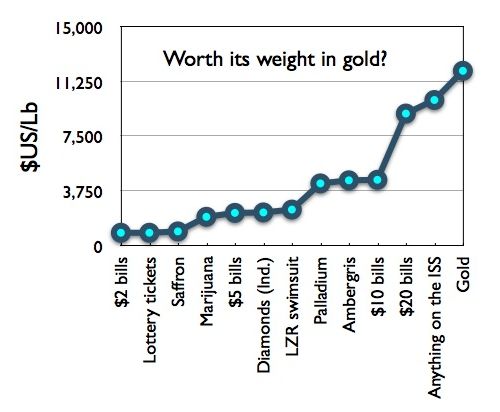
People have been saying that the new industrial grade swimsuits like the LZR Racer are worth their weight in gold. As you can see, this is clearly inaccurate. But such a suit is worth its weight in marijuana or industrial diamonds.
At the high end of this graph is gold (the only thing worth exactly its own weight in gold!), right next to the cost of launching a pound of stuff to low earth orbit on the ISS. Putting that into perspective here: You might as well build your whole spaceship out of $20 bills– it still would cost less than putting it up there. It could almost be made of solid gold for that price.
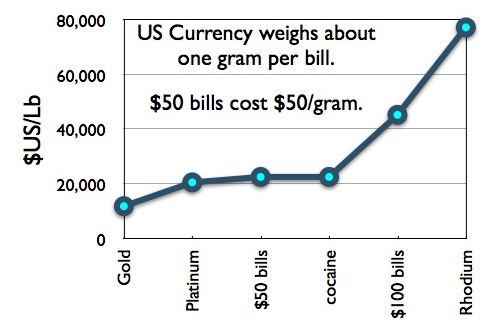
Of course, gold isn’t the only precious metal, or even the most expensive. That “honor” belongs to rhodium, whose price far exceeds that of its weight in $100 bills. There’s an interesting coincidence in this price range: Cocaine is about $50/gram, while a fifty dollar bill weighs about a gram. Even exchange? Platinum is also in the same price range, so you could say that $50 bills are worth their weight in platinum.

If we look at good-quality 1 carat diamonds, we find that they are quite expensive compared to the industrial diamonds we saw earlier. Now, the diamond monopoly hasn’t kept prices quite as high as LSD, however they are doing a very impressive job of trying. LSD doses measure in the micrograms, which makes the per-pound “street value” of the stuff astronomically high.
In the table that follows, we list our data with references, organized from cheapest to most expensive. A few of the items in the table didn’t make it into our graphs, including the last (and most expensive) item. Antimatter — presently made one subatomic particle at a time– would be unfathomably expensive in the bulk, some $26 Quadrillion per pound.
| Item | Price per pound |
|---|---|
| All purpose flour | $0.52 |
| Zinc | $0.80 |
| Lead | $0.85 |
| Bottled water | $1.00 |
| Pennies | $1.81 |
| Copper | $3.50 |
| Nickels | $4.54 |
| Nickel | $9.00 |
| Bulk hemp fiber | $12 |
| Dimes | $20 |
| Quarters | $20 |
| Turkey feathers | $26 |
| Maine Coon Cat (Pet quality ~20 lbs) | $50 |
| Dollar coins | $56 |
| Uranium (as U3O8) | $65 |
| Kobe Beef Filet Mignon | $112 |
| Kopi Luwak | $160 |
| Human Blood | $181 |
| Silver | $197 |
| Printer Ink | $322 |
| Peacock feathers | $410 |
| One Dollar Bills | $454 |
| Two Dollar Bills | $907 |
| Lottery Tickets (California $1 scratch-offs) | $907 |
| Saffron | $1,000 |
| Marijuana | $2,000 |
| Five Dollar Bills | $2,268 |
| Industrial diamonds | $2,300 |
| LZR Swimsuit | $2,495 |
| Palladium | $4,287 |
| Ambergris | $4,500 |
| Ten Dollar Bills | $4,536 |
| Twenty Dollar Bills | $9,072 |
| Any object brought to ISS | At least $10,000 |
| Gold | $12,000 |
| Platinum | $20,679 |
| Fifty Dollar Bills | $22,680 |
| Cocaine | $22,680 |
| Hundred Dollar Bills | $45,359 |
| Rhodium | $77,292 |
| Good-quality, one-carat diamonds | $11.4 M |
| LSD | $55 M |
| Antimatter | $26 Quadrillion |




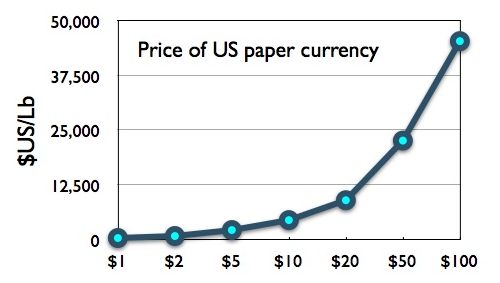
The phrase you are looking for is “worth its weight in aerogel.”
Aerogel 5$/100ml = $50/l, mass 1l air=1.293g/l, mass 1l aerogel (3x)=3.879g/l, aerogel = $50/3.879=$12.88/g, 1 pound=453.59g so aerogel = 5846.77 $/pound. I hope I didn’t make a mistake. Not too expensive, 1 pound would be 30 gallons….
They say it’s 3mg/cc, so the 100cc for $5 gives you only 0.3g.
$16666/lb.
I would not be putting it on my ice cream.
Previous poster was correct (except that he was using 3.879mg/cc). You forgot to convert kg -> lb:
$16,666/kg = $7,560/lb
Cheaper than gold – not to mention the volume discount! ;)
The 8gb iphone seems to get close –
– Weight 4.8 Ounces – 1
– Phone cost: $600 – 2
– Service cost: $2040 – 3
$2640 / 4.8 ounces = $550/ounce * 16 = $8,800 per pound of iphone
although the proper unit of measure for the iPhone would be a pound-year, perhaps.
"And… surprisingly enough, dimes and quarters have the same density, about $4.50 per pound, so you can pick either. (But as you can see, nickels are mighty inefficient. Avoid carrying them in your pockets whenever possible.)"
Actually, it looks like your eyes skipped a row. According to your chart and the data below, the nickels are about $4.50 per pound and dimes and quarters are $20 per pound.
Erik
always been too lazy to compare the price of the tobacco in a cigarette to other things. Anybody gotta gram scale?
Uranium’s atomic weight is 238, not 308 as you have listed.
That’s an “O” not a “0” — Triuranium octaoxide (U3O8) is a common commodity form of uranium. Google tells me: “An oxide form of uranium that is the most common chemical form found in nature. U3O8 is very stable and has a low solubility in water.”
—
Windell H. Oskay
drwho(at)evilmadscientist.com
http://www.evilmadscientist.com/
Actually, that’s not meant to be the atomic weight but "triuranium octoxide" (http://en.wikipedia.org/wiki/Triuranium_octaoxide).
Sigh, chemists. That would be the mineral pitchblende, a common uranium ore. Yellowcake, UF6, reactor- and bomb-grade refined uranium would all rate a little higher on the price/pound scale.
And why are we measuring things in units of force anyways? I know you learned about mass in high school, dammit!
Well, okay, I suppose you can be forgiven given the circumstances …
— Dave
Marijuana is not $2000 a pound.
i noticed about 3 years ago that an ounce of gold and an ounce of decent pot both cost $300. today the same pot is still $300 but gold is between double and triple that.
but i digress, a pound of pot wholesale (of the same quality as i mentioned above) is between 2800 and 3200. which would retail between 4000 and 5000, depending on how you bust it down
[citation needed]
—
Windell H. Oskay
drwho(at)evilmadscientist.com
http://www.evilmadscientist.com/
Pot is between $1,000 and $1,800 per pound wholesale where I live.
Cigarettes all weigh exactly one gram, king size or not.
and the filter weighs how much of that? Figuring a pack and a half would cost $13.50 in England…
Bottled water: this is evil and deserves more than a ‘1.0’ per pound recognition:
1 gallon of water equals 8.33 lbs.
A pound of bottled spring water from fiji
A pound of bottled distilled water (generic brand) – about $1.00 for 8.33 lbs.
A pount of Aquafina filtered tap water: $2.35 for 32 oz. 1 US gallon = 128 US fluid ounces
You could write a whole-nuther entire article using bottled water as the base instead of a pound of gold.
I would digg that.
Tap water: 18 hundred-thousandths of a dollar per pound, delivered. That’s $0.00018, by far cheaper than anything in the table above.
This is based on 15,000 gallons at a stepped rate of $10.25 for the first 5000 gallons, $1 per thousand for the next 5,000 and $1.5 per thousand for the next 5,000 and ignoring the sewer fee, which might double the cost.
It helps when you take advantage of the fact that you’re already buying in “bulk”.
Not sure where you are getting your weed, but where I come from it hovers around $300/once. I’ve heard an ounce of NYC Diesel can be $1,000 … I’ve heard. I… I don’t actually know that for sure … Your not a cop are you?
Someone else is complaining that our number is too low.
As we said, our numbers are “rough estimates, believed to be more-or-less correct.” Based on your comment and the other, I’d guess that we’re within a factor of two of the right value.
—
Windell H. Oskay
drwho(at)evilmadscientist.com
http://www.evilmadscientist.com/
Pure Botulinum A, the active ingredient in botox, is supposed to be extremely expensive. Doses are nanograms (since it’s lethal at 1nanogram/kilo), and only something like a few milligrams are produced. I can’t find a place to buy it, though ;-)
It would could approximately 400 times the Gross World Product (~$65 trillion) to produce a pound of antimatter.
And if you dropped it… the explosion yield could be as high as 19 Megatons. I for one am *happy* that we don’t have pounds of the stuff lying around.
—
Windell H. Oskay
drwho(at)evilmadscientist.com
http://www.evilmadscientist.com/
The US coins were originally intended to be ‘worth their weight’ in the metal they were made from. Pennies were originally made of copper, Nickels of (*gasp*) nickel, and Dimes and Quarters of silver. Since then things have changed, and these coins are now made of cheaper alloys, but the weight ratio between the dime and quarter are, in fact, for a reason.
These really should be bar graphs. Line graphs are most commonly used to show trends over time, not comparisons of individual things. However, since it’s interesting and funny, you get a pass. This time.
Agreed in principle. However it’s often much more difficult to visually compare items on bar charts– you need a pretty good grid behind the chart to assist the viewer.
—
Windell H. Oskay
drwho(at)evilmadscientist.com
http://www.evilmadscientist.com/
Just for clarity, the US cent switched to copper clad zinc during 1982 (both types were produced that year). The 1837 change was from pure copper to 95% copper.
Cents dated 1982 can be distinguished by flipping them. When your thumbnail strikes the zinc coin you hear a thud. A coin with copper alloy rings.
If you added post-1964 half dollars and Eisenhower dollars to chart one, they would *also* be the same as dimes and quarters — again, due to the fact that the original size was set by silver value.
Thus, we derive the cost of the Vietnam war expressed in tons of LSD: 5.3
Or 9.1 tons of heroin (street price)
Printer ink?
Our price reference for the ink is linked above.
—
Windell H. Oskay
drwho(at)evilmadscientist.com
http://www.evilmadscientist.com/
Part of my job (at a national lab) is producing something called ultra-cold neutrons. These are the usual sub-atomic particles, but slowed down so far that a human can outrun them. My project’s budget is about 1 million smackers per year, and we produce about 10,000 ultra-cold neutrons per second. I may have screwed up, but at a mass of 1.6×10^-27 kg/neutron, that comes to a price of about 10^21 $/lb., or about 40000 times the cost of antimatter. I may have dropped some digits, though.
Your math looks right– but I’d guess that cold neutrons are as hard to put on a scale as antimatter is.
Our list isn’t exhaustive by any stretch. Here’s another good one: Ununbium (element 112) is still *way* more expensive per pound than cold neutrons. :)
—
Windell H. Oskay
drwho(at)evilmadscientist.com
http://www.evilmadscientist.com/
> <i>"And… surprisingly enough, dimes and quarters have the same density, about $4.50 $20 per pound,"</i>
Not surprising in the slightest. Remember that once upon a time almost all US coins were made of gold or silver. The penny and the nickel were exceptions to this (which is a story in itself).
The value of the coins was based upon their silver content. A quarter was one-fourth the value of a dollar because it had one-fourth the silver. Therefore, all of our old silver coins had a fixed value to density ratio; the old three-cent coin, the half-dime (yes, the half-dime, not the nickle), the dime, the half dollar, and the dollar.
When they switched from silver to cupronickel alloy, they naturally changed the value to density ratio, but of course they couldn’t change the fact that the coins all were fixed in size and hence the ratio changed simultaneously.
So, no surprise at all.
Making something ultra-cold and slow doesn’t seem fair. I could just outdo you by spending more money and making it slightly colder. Where do we draw the line?
i think you could be beaten by the prize for a pound of Quirks (is that how they call them?) collected from the ATLAS shield in the LHC. Well, if they find any.
What about the monetary density of gasoline. At the current cost of about $4/gallon, or about 50c/lb it would have the lowest value density of everyday items on your list!
Your calculation seems to use a weight of 8 lbs/gal for gasoline which actually weighs about 6.175 lbs/gal. At $4/gal, the price per lb would be about 64.8 cents. At the pre-Gustav price of $3.249, it would be about 52.6 cents per pound. That’s very close to the price given for all-purpose flour.
Which of course is the main problem in producing biofuel and other alternative fuels.
We already know how to make biofuel (and not just ethanol either). But if you try to manufacture *any* chemical at less than $4/gallon and in huge quantities, you run into huge logistical and efficiency issues. Far more profitable to make other chemicals for the chemical or pharmaceutical industry, which can range from tens to thousands of dollars per gallon…
Your price for saffron is quite a bit high. Here is Australia I buy 5 grams of saffron for $5, or $1 per gram. There are about 454 grams per pound so you are about double what the retail price in Australia.
A factor of two– especially considering the state of the US economy– is hardly "quite high." Also, the prices between different grades of saffron vary considerably more than a factor of two, so your data point does not contradict ours in the first place.
—
Windell H. Oskay
drwho(at)evilmadscientist.com
http://www.evilmadscientist.com/
There are a few major world producers of saffron inside of Australia as well. I don’t know if there are saffron farms in the US or if it’s all imported, but I’d be very surprised if that wasn’t a factor in the relative prices.
So Windell – Hows about I supply you with cheap Australian Saffron and you corner the US market? ;-)
1929 BC sold coverage at 50c / m
1950 about $2 /m
1976 $36/m if u qualified in n.e. states
1999 some families pay $10,000/yr for HMO etc
HMOs are massless, and therefore irrelevant to this discussion.
—
Windell H. Oskay
drwho(at)evilmadscientist.com
http://www.evilmadscientist.com/
The inertia (resistance to change in momentum) of a typical HMO seems to imply a very great mass. As does their gravitational attraction of premiums and the high escape velocity required for benefits to leave orbit.
PPOs, on the other hand, obviously have relatively smaller mass.
Through careful observation and experimentation, one could work out the entire periodic table of the insurance industry.
Really brilliant Windell.
UCN are probably not a fair comparison…lots of things can be made cold. Exotic forms of matter (trans-U, anti-) are good. What about art? The finest Picaso , Monet weigh very little. Or the nutters who buy stamps or baseball cards?
And what about humans…I have a couple sons and wife…priceless to me, but honestly. All humans (to first approximation) have the same weight (except modern day Americans (x 1.5)), therefore their worth is in what they have given back to humanity. Are Einstein’s contributions worth something? Probably a great deal, but not as much as Johannes Gutenberg…inventor of printing press…he is probably worth more than any human to have walked the planet.
By the same reasoning, humans can and do actually have negative worth. Any number of criminals can be an enormous economic burden on society? But maybe those criminals that we spend a lot of money on are actually worth alot? Interesting. So it is really the dullest person who has walked the planet who is the most worthless person to have ever lived…never causing trouble, never doing anything right or wrong.
Kevin Henderson
LANL
Your government has likely already valued your life. Government economists decide where to spend government money (healthcare budget, transport budget etc.) based on what it would cost to implement per capita. I think the magic number in Australia is something like $45000. If it costs more than that per year per person, it’s not going to happen.
So, you take the life expectancy of a person in your country, subtract your age, multiply by the magic number and you have the monetary value of your life :).
If neutrinos have mass (>2.2 eV) they will get at least 10^8 enhancement over normal periodic table stuff. Of course you can’t put them in a box anyhow.
Photons do not have mass (EM or standard model say so), so they are in principle ‘priceless’.
Just some more thoughts.
Kevin Henderson
LANL
If you put the photons in a box they contribute E/c^2 = h/cλ mass to the system. A pound of blue (400nm) photons would thus consist (if we’re going to be sloppy with mass and weight then I claim this is reasonable) of 8*10^34 photons or 40PJ of energy worth around 1G$ as electricity.
Wikipedia reports that Bill Gates’ net worth is $56 billion and he looks to be about 180 lbs (maybe a bit more), therefor his monetary density is roughly $311 million / lb.
I think the estimate for marijuana prices is a bit off. I posted about this on my blog at socialjewstice.blogspot.com.
Basically, the figures used in this analysis are low for current estimates of marijuana prices dependent on location, quality, and retail-quality value. Mid-range estimates put marijuana easily in the $6400 to $9600 per pound range.
How about Botox?
At 5 nanograms of volume placed in each bottle which sells for nearly $500 per bottle to providers, that makes its value over 1 trillion dollars per pound!
Sounds like somebody has been doing some original research.
From a practical standpoint two things must be considered 1) there must be an actual market for the substance or object in question 2) the weight of the storage medium or container must be considered if the object or substance in question requires one. By this measure the Treskilling Yellow stamp which weighs 250 mg and last changed hands in 1996 at 2.5 million swiss francs would cost about 5 billion dollars a pound by this transaction giving it the highest monetary density currently.
If you want to introduce market forces, that complicates things. If stamps like that were available by the pound, there’s no reason to assume that they would be so expensive.
—
Windell H. Oskay
drwho(at)evilmadscientist.com
http://www.evilmadscientist.com/
The only reason I used a pound as unit of comparison was because previous posters had used it. One could easily use a dollars per milligram instead, in which case the stamp would hold it’s value at that level, since it weighs more. To quote values for items that have no market ( ex anti-matter) is meaningless. Incidentally further analysis reveals that Treskilling Yellow Banco stamp actually weighs only 25 milligrams and it’s current value is estimated at 10 million dollars (U.S.) giving it a value of $400,000 (U.S.) / milligram.
No market for anti-matter?
I’ll gladly pay you Tuesday for a ton today. Something’s got to power the flux capacitor and gravy plants, right?
Ahh, I remember the days when that stuff was called Ununbium… Now it’s Copernicium.
A helium filled balloon at neutral buoyancy , measured in the same manner as the other commodities would have an infinite dollar per pound ratio. making helium balloons more expensive than antimatter.
Well where im from you can get an ounce of marijuana for about 150 bucks but this is a great comparison to use. And about the uranium, you would need to make the yellow cake into purified uranium which i doubt any normal person is capable of lol
try 1500 outdoor and 2700-5 or 6 pending geography, crazy thing is outdoor organic is where its at but are culture of marketing and consumption is being fed chemical and nutrient laden designer bud at a premium, just like were paying 10,000 for 500. wells in afganistan that dont really get built anyway? It doesn’t seem to be reasonable but then it must make sense to those in charge…with the guns….and the ever devaluing currency machine 3.5 trillion and counting, I wonder what our outstanding balance sheet is worth a pound? Im sure its a lot of paper! :)
i guess thats we like investing in prisons and corrupt legislative structures in Ca because we have found out hot to keep citizens alive for a dollar a day on a $20 gov subsidy 2000 % return not bad in a down trending econo…uh recession? How do others see what is happening. 3.5 Trillion, trains in england since 1600’s and we still dont have a train that runs along the west coast of north america. We are still in the planning stages of a still birth project for a train that connects santa rosa to marin a distance of maybe 45 miles and 20 short of the sf trans bay terminal, God the 1600s! But we got GM, literally we own it now, and then sprouted standard oil and the west coast petroleum boom monopoly. Locked into cars because of Robert Moses who with ford and gm decided americas future would be cast in dirty loud car culture; because that’s what suited their characters, personalities and profits. One man? At that time that man could have made a difference.
There is no difference in measureing per pound or per mass. Everything would just be divided by a constant. For example.
1lb=1slug * (32.2 ft/s^2)
1N=1kg* (9,8 m/s^2)
So, as you can see, the graphs would be identical to what they are now. They would just have their $/lb decreased to $/slug by a factor of 32.2.
And since the slug is so rarely used in physics, we just use lb=mass, lbf=lb force.
-im a mechanical engineer-
Aerogel 5$/100ml = $50/l, mass 1l air=1.293g/l, mass 1l aerogel (3x)=3.879g/l, aerogel = $50/3.879=$12.88/g, 1 pound=453.59g so aerogel = 5846.77 $/pound. I hope I didn’t make a mistake. Not too expensive, 1 pound would be 30 gallons….